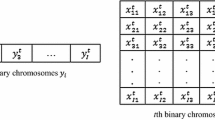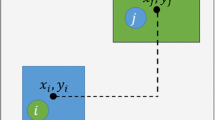Abstract
We consider discrete competitive facility location problems in this paper. Such problems could be viewed as a search of nodes in a network, composed of candidate and customer demand nodes, which connections correspond to attractiveness between customers and facilities located at the candidate nodes. The number of customers is usually very large. For some models of customer behavior exact solution approaches could be used. However, for other models and/or when the size of problem is too high to solve exactly, heuristic algorithms may be used. The solution of discrete competitive facility location problems using genetic algorithms is considered in this paper. The new strategies for dynamic adjustment of some parameters of genetic algorithm, such as probabilities for the crossover and mutation operations are proposed and applied to improve the canonical genetic algorithm. The algorithm is also specially adopted to solve discrete competitive facility location problems by proposing a strategy for selection of the most promising values of the variables in the mutation procedure. The developed genetic algorithm is demonstrated by solving instances of competitive facility location problems for an entering firm.





Similar content being viewed by others
References
Dorigo, M., Gambardella, L.M.: Ant colony system: a cooperative learning approach to the traveling salesman problem. IEEE Trans. Evol. Comput. 1(1), 53–66 (1997). doi:10.1109/4235.585892
Eberhart, R., Kennedy, J.: A new optimizer using particle swarm theory. In: Proceedings of the Sixth International Symposium on Micro Machine and Human Science, MHS ’95, pp. 39–43 (1995). doi:10.1109/MHS.1995.494215
Farahani, R.Z., Rezapour, S., Drezner, T., Fallah, S.: Competitive supply chain network design: an overview of classifications, models, solution techniques and applications. Omega 45, 92–118 (2014)
Francis, R.L., Lowe, T.J., Tamir, A.: Demand point aggregation for location models. In: Drezner, Z., Hamacher, H. (eds.) Facility Location: Application and Theory, pp. 207–232. Springer, Berlin (2002)
Friesz, T.L., Miller, T., Tobin, R.L.: Competitive networks facility location models: a survey. Papers Reg. Sci. 65, 47–57 (1998)
Glover, F.: Heuristics for integer programming using surrogate constraints. Decis. Sci. 8(1), 156–166 (1977). doi:10.1111/j.1540-5915.1977.tb01074.x
Hakimi, L.: Locations with spatial interactions: competitive locations and games. In: Mirchandani, P.B., Francis, R.L. (eds.) Discrete Location Theory, pp. 439–478. Wiley, New York (1990)
Hakimi, L.: Location with spatial interactions: competitive locations and games. In: Drezner, Z. (ed.) Facility Location: A Survey of Applications and Methods, pp. 367–386. Springer, Berlin (1995)
Holland, J.H.: Adaptation in Natural and Artificial Systems. The University of Michigan Press, Ann Arbor (1975)
Huff, D.L.: Defining and estimating a trade area. J. Mark. 28, 34–38 (1964)
Pelegrín, B., Fernández, P., García, M.D.: On tie breaking in competitive location under binary customer behavior. OMEGA Int. J. Manag. Sci. 52, 156–167 (2015)
Plastria, F.: Static competitive facility location: an overview of optimisation approaches. Eur. J. Oper. Res. 129(3), 461–470 (2001)
ReVelle, C.S., Eiselt, H.A., Daskin, M.S.: A bibliography for some fundamental problem categories in discrete location science. Eur. J. Oper. Res. 184(3), 248–259 (2008)
Serra, D., ReVelle, C.: Competitive location in discrete space. In: Drezner, Z. (ed.) Facility Location: A Survey of Applications and Methods, pp. 367–386. Springer, Berlin (1995)
Shaikh, A., Salhi, S., Ndiaye, M.: New MAXCAP related problems: formulation and model resolution. Comput. Ind. Eng. 85(3), 817–848 (2015)
Suárez-Vega, R., Santos-Penate, D.R., Dorta-Gonzalez, P.: Discretization and resolution of the (\(r|{X}_p\))-medianoid problem involving quality criteria. TOP 12(1), 111–133 (2004)
Törn, A., Žilinskas, A.: Global Optimization. Springer, New York (1989)
Acknowledgments
This research was funded by a grant (No. MIP-051/2014) from the Research Council of Lithuania.
Author information
Authors and Affiliations
Corresponding author
Rights and permissions
About this article
Cite this article
Lančinskas, A., Fernández, P., Pelegín, B. et al. Improving solution of discrete competitive facility location problems. Optim Lett 11, 259–270 (2017). https://doi.org/10.1007/s11590-015-0930-3
Received:
Accepted:
Published:
Issue Date:
DOI: https://doi.org/10.1007/s11590-015-0930-3




